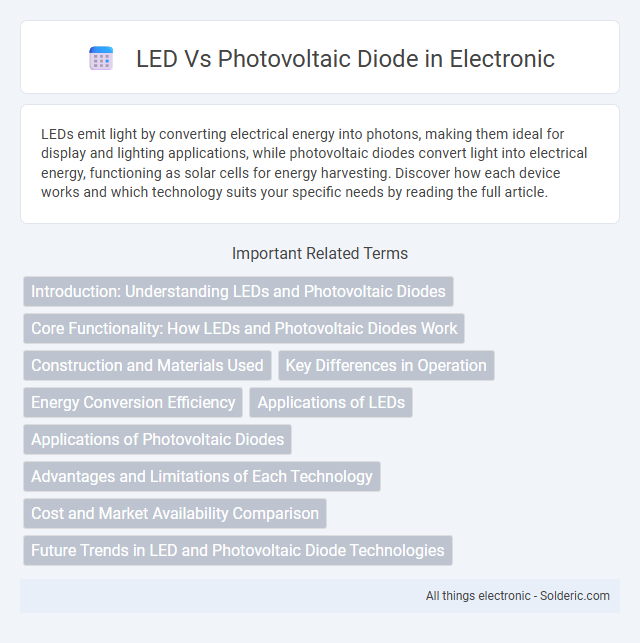LEDs emit light by converting electrical energy into photons, making them ideal for display and lighting applications, while photovoltaic diodes convert light into electrical energy, functioning as solar cells for energy harvesting. Discover how each device works and which technology suits your specific needs by reading the full article.
Comparison Table
| Feature | LED (Light Emitting Diode) | Photovoltaic Diode (Solar Cell) |
|---|---|---|
| Primary Function | Emit light when electric current passes | Convert light energy into electrical energy |
| Operation Principle | Electroluminescence | Photovoltaic effect |
| Material | Semiconductor (e.g., GaAs, InGaN) | Semiconductor (e.g., Silicon, CdTe) |
| Electrical Characteristics | Forward biased, low voltage (~2V) | Generates voltage under illumination, reverse biased in dark |
| Purpose | Light indication, displays, lighting | Energy harvesting, power generation |
| Efficiency | Light conversion efficiency varies 20-40% | Energy conversion efficiency typically 15-22% |
| Response Time | Nanoseconds to microseconds | Milliseconds to seconds |
| Physical Structure | PN junction designed for emission | PN junction optimized for light absorption |
Introduction: Understanding LEDs and Photovoltaic Diodes
LEDs (Light Emitting Diodes) convert electrical energy into light through electroluminescence, commonly used in displays and lighting applications. Photovoltaic diodes, or solar cells, operate by converting light energy into electrical energy using the photovoltaic effect, essential in solar power generation. Understanding your application determines whether an LED or photovoltaic diode is the ideal component for efficient energy conversion.
Core Functionality: How LEDs and Photovoltaic Diodes Work
LEDs emit light by passing an electric current through a semiconductor material, causing electrons to recombine with holes and release energy in the form of photons. Photovoltaic diodes convert light into electrical energy by absorbing photons, which excite electrons, generating a voltage and current through the photovoltaic effect. While LEDs function as efficient light sources, photovoltaic diodes serve as light sensors or solar energy converters based on their opposite semiconductor operations.
Construction and Materials Used
LEDs typically consist of semiconductor materials such as gallium arsenide (GaAs) or gallium nitride (GaN), constructed with layered p-n junctions designed to emit light when an electric current passes through. Photovoltaic diodes, or solar cells, are generally made from silicon--either monocrystalline or polycrystalline--with a p-n junction engineered to absorb photons and generate electrical current. While LEDs focus on efficient electroluminescence with specific doping to emit light, photovoltaic diodes emphasize maximizing light absorption and electron-hole pair separation to convert solar energy into electricity.
Key Differences in Operation
LEDs emit light when an electrical current passes through a semiconductor, causing electron-hole recombination that releases photons. Photovoltaic diodes operate by absorbing photons to generate electron-hole pairs, converting light into electrical energy via the photovoltaic effect. Understanding these key differences in operation helps you choose the right component for applications like lighting or solar energy harvesting.
Energy Conversion Efficiency
Photovoltaic diodes convert sunlight into electrical energy with higher energy conversion efficiency compared to LEDs, which primarily convert electrical energy into light. The energy conversion efficiency of photovoltaic diodes can reach up to 22-26% in commercial silicon solar cells, while LEDs typically operate at about 20-40% efficiency in converting electricity to visible light. Optimizing your choice between LED and photovoltaic technology depends on whether your goal is effective light emission or maximized solar energy harvesting.
Applications of LEDs
LEDs find widespread applications in display technology, general lighting, automotive indicators, and medical devices due to their energy efficiency and long lifespan. They are integral in backlighting for screens, traffic signals, and smart home systems, contributing to reduced energy consumption. Your choice of LEDs can enhance both brightness and durability in various electronic and industrial applications.
Applications of Photovoltaic Diodes
Photovoltaic diodes are primarily utilized in solar energy harvesting systems, converting sunlight directly into electrical energy for residential, commercial, and industrial power applications. They play a critical role in autonomous sensors, powering remote or off-grid devices by providing a reliable energy source through ambient light absorption. Additionally, photovoltaic diodes support energy-efficient battery charging systems and contribute to sustainable electronic designs by enabling low-power, renewable energy solutions.
Advantages and Limitations of Each Technology
LEDs offer high energy efficiency and long lifespan, making them ideal for lighting applications with precise control over light emission, but they have limited energy conversion capabilities. Photovoltaic diodes excel at converting solar energy into electricity with high conversion efficiency under optimal light conditions, yet their performance drops significantly in low light and they require substantial surface area for effective power generation. Each technology's advantages and limitations dictate their suitability for applications such as illumination for LEDs and renewable energy harvesting for photovoltaic diodes.
Cost and Market Availability Comparison
LEDs generally have lower production costs due to mature manufacturing processes and widespread market availability, making them highly accessible for consumer and industrial applications. Photovoltaic diodes, while more expensive per unit, benefit from economies of scale in solar power markets but remain costlier due to specialized materials and lower production volumes. Market availability of LEDs spans global electronics suppliers, whereas photovoltaic diodes are primarily sourced from renewable energy component manufacturers with a narrower distribution.
Future Trends in LED and Photovoltaic Diode Technologies
Future trends in LED technology emphasize advancements in energy efficiency, miniaturization, and integration with smart systems, aiming to enhance lighting quality and reduce power consumption. Photovoltaic diode developments focus on improving conversion efficiency through novel materials like perovskites, tandem cells, and flexible substrates to expand applications in wearable and portable energy solutions. Both technologies benefit from nanostructuring techniques and artificial intelligence-driven optimization, driving innovations in sustainable energy and optoelectronics.
LED vs Photovoltaic diode Infographic

 solderic.com
solderic.com